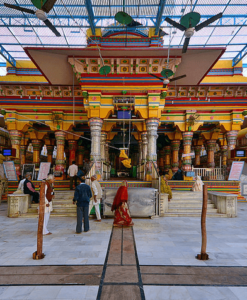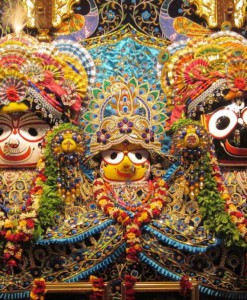The Jagannath Temple of Puri is a famous, sacred Hindu temple dedicated to Jagannath and located on the eastern coast of India, at Puri in the state of Odisha.
The temple is an important pilgrimage destination for many Hindu traditions, particularly worshippers of god Krishna and god Vishnu, and part of the Char Dham pilgrimages that a Hindu is expected to make in one’s lifetime.
Even though most Hindu deities that are worshiped are made out of stone or metal, the image of Jagannath is wooden. Every twelve or nineteen years these wooden figures are ceremoniously replaced by using sacred trees, that have to be carved as an exact replica. The reason behind this ceremonial tradition is the highly secret Navakalevara (‘New Body’ or ‘New Embodiment’) ceremony, an intricate set of rituals that accompany the renewal of the wooden statues.
Jagannath Temple, Puri;
Originally, Jagannatha was worshipped as Nila Madhava by an aboriginal chief secretly at this spot, while it was covered with dense forest. It was Indradyumna, who made him a public deity. The story goes, there was a king in Malwa in central India, Indradyumna by name. He was a great devotee to Vishnu. For those who are not acquainted with the names of Hindu gods and goddesses, it may be stated here that the Hindus believe in the cosmic trio namely Brahma, Vishnu and Shiva. Brahma is the creator of the universe, Vishnu is the sustainer and Siva is the destroyer.
Indradyumna developed in him a rather queer and eccentric desire to see Vishnu in his most perfect form on the face of the earth. He had a divine communication in dream that Vishnu could be seen in his best form in Utkala (another name of ancient Odisha). So, he deputed Vidyapati, the brother of the royal priest, to spot out the place where Vishnu had such a manifestation and to report his findings to him. Accordingly, Vidyapati visited Odisha and after laborious search, came to know that Vishnu known by the highly connotative name of Nila Madhava, was being worshipped somewhere on a hill in a dense forest. This was also an image of extraordinary lusture. Vidyapati could also know that Nila Madhava was the family-deity of Visvavasu, a Savara (an aboriginal tribe) chief.
So great was the secrecy maintained about the location of Nila Madhava that Visvavasu refused on request to show Vidyapati the place of his worship. Later still, this Brahmin married Lalita, the daughter of the aboriginal chief, but even then, he was not shown the deity. At last, at the request of his beloved daughter, he took his son-in-law blindfolded to a cave on a hillock where Nila Madhava was being worshipped. As Vidyapati was made to go through the forest on foot, he could somehow manage to drop mustard seeds on the ground. As the seeds germinated after a few days, Vidyapati could easily trace the way to the lonely cave of Nila Madhava.
Thereafter, Vidyapati returned to Malwa and described his experiences to Indradyumna who immediately set out on a pilgrimage to Odisha. But, when he reached this holy land, he found that Nila Madhava had miraculously disappeared. When he was thus in a state of deep sorrow, he received a divine direction to go to the sea-shore at Puri and to draw ashore a log of wood that would be floating on the waves. From this divine log, the body of Jagannatha, who is no other than Vishnu himself, was to be fabricated in a befitting manner. , All this came to pass as per the divine indication and a log of wood brought from the sea was ready for fabrication of the image of Jagannatha out of it.
But there was none to be entrusted with the work, since nobody could say that he had seen Vishnu and could convince the king as to how Vishnu could be fabricated in his best form out of a log of wood. At last, Vishnu took pity on his great devotee and appeared before him as an old carpenter. After some discussion, he could evoke confidence in the king about his capabilities. As per his suggestion; it was decided that he should be allowed to remain in a closed room with the log of wood for long twenty one days to do the needful. He gave a severe warning that under no circumstances should he be disturbed or the door be opened within the specified date.
The story goes, after fifteen days, Gundica, the queen, being very kind-hearted, could not resist the temptation to persuade the king to open the door as she apprehended that the carpenter might have died by then, as, no sound of any kind was heard from within. Thus, when the door was opened at the king’s command, no trace of the carpenter could be found and all that could be seen was a set of four wooden images in incomplete form, i.e., the form in which we see and worship the images of Jagannatha, Balabhadra, Subhadra and Sudarsana at present.
The Puri temple is built on a gigantic raised platform in the heart of the city, The temple complex is enclosed by a wall about seven meters high -including the 0 height of the platform. The area of this platform is more than 4,20,000 sq.ft. The wall is pierced by four gates ,facing the four directions. On the east-facing gate, there are stone images of two lions and it is called the Lions Gate. The north, south and west facing gates are similarly known as the Elephant Gate, the Horse Gate and the Tiger Gate (also called the Khanja Gate) respectively.
The north gate is mainly meant for the God himself in as much as, the logs of wood out of which, the images are fabricated, make their entry into the temple premises through this gate, when the Navakelevara ceremony takes place. The east-facing Lions Gate is the main gate. There are pyramidal structures over the four gates, which are not very old.
As we arrive at the vast open area in front of the Lions Gate (eastern gate), we see a monolithic pillar about 10 meters high. This pillar is known locally as the Aruna Stambha. In Hindu mythology Aruna is the the charioteer of the Sun-god, The world famous Konark Sun temple was designed in the form of a stupendous chariot and this monolithic pillar with the beautifully carved Aruna seated on its top was installed right in front of the porch of that temple. When the temple was abandoned and there was no presiding deity in it, this pillar was removed from Konarka to Puri and was fixed in front of Jagannatha temple where we see it now.
Immediately after we get into the main gate and proceed forward, we find ourselves on a flight of steps. Locally, they are called Baisi Pahaca, which literally means, twenty-two steps. The history or rather the mystery of this flight of steps has not been unveiled. It is interesting to note that great reverence is shown to this flight of twenty-two steps. The parents bring their children & make them slowly roll over the steps from the top to the bottom ones in expectation of spiritual bliss in as much as countless devotees have walked on the steps which are believed to be throbbing with spiritual animation.
As we cross the main entrance on the east and ascend the flight of steps leading to the main temple, we find on the left-hand side, a vast kitchen area of the temple. Some tourists rightly observe that on account of this kitchen, the Puri temple may be described as the biggest hotel of the world. It can feed even one lakh persons with only two to three hours’ notice. The method of preparation is most hygienic and the traditional process of preparation of food for so many people in so short a time, takes many by surprise. To the right, we have the Ananda Bajara which is the popular name of the food selling market within the enclosure. Ananda Bajara literally means, the pleasure market.
By Rail: Puri is a terminus on the East Coast Railway having direct express and super fast train links with New Delhi, Mumbai, Kolkata, Okha, Ahmedabad, Tirupati etc. Some important trains are Kolkata (Howrah) Puri Howrah Express, Jagannath Express; New Delhi; Purushottam Express. Khurda Road Station, 44 km, from Puri is convenient rail head for train to Chennai and Western India.
By Road: The bus stand near the Gundicha Temple provides connections to Bhubaneswar and Cuttack, service every 10-15 minutes. Minibuses to Konark leave every 20-30 minutes and also from Jatiababa Chhak. There are direct buses for Kolkata and Visakhapatnam.
By Air: The nearest airport is Bhubaneswar, 60 km.
This temple Opening & Closing times is 5.00 AM and 9.00 PM. During this period major part of the Lord Jagannath rituals are performed. Archana, Aarti and Abhisekham are the daily pujas performed.
The festivals of the temple draw huge crowds not only from Odisha but also from other states of India. The festivals are, no doubt, occasions of great religious experience and devotional fervour but they are also occasions for trade, industry, commerce and business activities in Puri.
A festival in this connection is known as a ‘Yatra’, which simply means a visit. Some of the most important festivals are as follows
• Chandana Yatra
• Snana Yatra
• Ratha Yatra
• Dola Yatra






